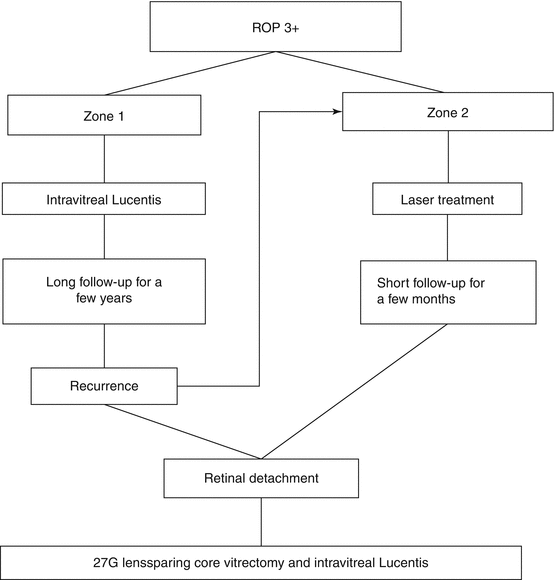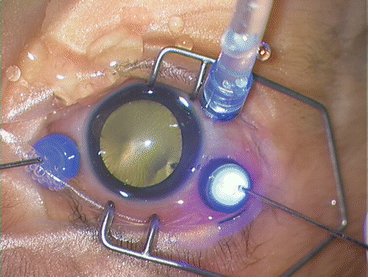and Mitrofanis Pavlidis2
(1)
Department of Ophthalmology, Uppsala University Hospital, Uppsala, Sweden
(2)
Augencentrum Köln, Cologne, Germany
17.1 General Introduction
17.4 Timing of Surgery
17.5 Surgery
17.5.1 Surgery Step by Step
17.6 Complications
17.7 FAQ
Electronic supplementary material
The online version of this chapter (doi:10.1007/978-3-319-20236-5_17) contains supplementary material, which is available to authorized users.
Electronic supplementary material
for this chapter is accessible online at http://extras.springer.com/ by searching via the ISBN.
17.1 General Introduction
We operate all children eyes with 27G. The reason for this is that the sclera of young eyes is soft and leaks more easily than an adult eye. In addition, we perform a perpendicular and not a lamellar insertion of trocars due to the risk of damaging the lens. If you perform a perpendicular insertion with 23G or 25G trocars, you need to suture the sclerotomies. In 27G a suture is not necessary and the sutureless vitrectomy allows a fast postoperative recovery.
17.2 Physiology of a Neonate Eye
In the neonatal eye, the pars plana region is incompletely developed and almost not existent. The axial length of a newborn eye is 16 mm in the 34th gestational week and 17 mm in the 40th gestational week. The anterior retina lies just behind the pars plicata. The site of sclerotomy is therefore much closer to the limbus. The sclerotomy should be performed 1.0 mm behind the limbus. See Table 17.1. The newborn eye has a huge lens compared to the globe. A big lens and a short sclerotomy site allow only a small canal to insert and manoeuvre the instruments. Utmost care is needed in inserting a vitreoretinal instrument or in administering an injection, because it may cause inadvertent lens touching, traction on the vitreous base and retinal damage. The vitreous body is completely intact; there is no degeneration of the vitreous body present. The vitreous body is very firmly attached to the retina; a PVD is virtually not possible. If you try to induce a PVD, you risk creating a retinal tear.
Table 17.1
Site of sclerotomy in relation to the age
Age | 0 | 1–6 months | 6–12 months | 1–3 years | 3–6 years | 6–18 years | Adult phakic | Adult pseudophakic |
Site of sclerotomy (mm) | 1.0 | 1.5 | 2.0 | 2.5 | 3.0 | 3.5 | 4.0 | 3.5 |
17.3 Retinal Detachment Secondary to ROP
ROP is a tractive retinal detachment and not a rhegmatogenous retinal detachment. Due to the fact that a retinal break is not present, there is no need for a tamponade or even postoperative posture. The aim of surgery is to remove the vitreous body in order to relieve retinal traction. The retina will reattach in a few days after surgery. In addition, an anti-VEGF injection is needed to reduce the vascular activity and remove the pathologic reason of the tractive detachment. We use ranibizumab (Lucentis®) because the half-life in serum is lower compared to bevacizumab (Avastin®).
In a 4A and 4B detachment, the state-of-the-art method may be to use the sutureless 27G technique, to perform a lens-sparing vitrectomy and to inject intravitreal Lucentis.
17.4 Timing of Surgery
Timing of surgery is of utmost importance. We only operate ROP stage 4A (retinal detachment and attached macula) and 4B (retinal detachment and detached macula). See Fig. 17.1. We do not operate stage 5 ROP. Do not operate too late. The risk that you will not succeed is high, and the risk that you will have complications is even higher. Try to operate in stage 4A.


Fig. 17.1
Our treatment algorithm for treatment of ROP
17.5 Surgery
Video 17.1: ROP_RE
Video 17.2: ROP_LE
The surgery is easy but you have to operate absolutely without complications: No lens touch, no retina touch and no retinal tear. A lens touch will result in a lensectomy and amblyopia. A retinal touch with retinal tear will result in retinal detachment and blindness. Be careful when inserting the trocars and instruments. Aim towards the optic nerve. Perform a central and peripheral vitrectomy. Do not induce a PVD; it is almost impossible in newborn. Do not remove membranes; you may induce a retinal tear. A tamponade is not necessary.
17.5.1 Surgery Step by Step
Instruments
1.
3-port 27G trocar system
2.
120D lens
Medication
Lucentis®, alternatively Avastin®
Tamponade
None
Individual Steps
1.
3-port 27G trocar system
2.
Core vitrectomy
3.
Peripheral vitrectomy
4.
Injection of 0.05 ml Lucentis
5.
Removal of trocar cannulas




